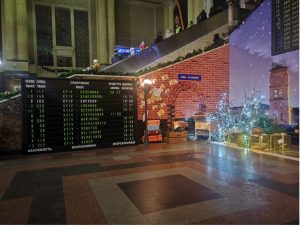December 13, 2022 – January 1, 2023
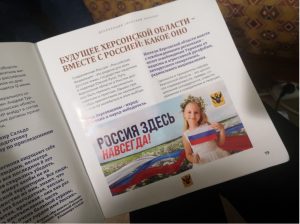 By mid-December, I had planned a trip to Kherson twice. I’ve never been there before, nor to other cities of the Ukrainian south and south-east, and knowing they have turned into unlivable ruins means I’ve missed an encounter with a big part of my country. The railroad connection with liberated Kherson was restored almost immediately on November 19th, and since then the city is constantly on my mind. I have been figuring out the needs and contacts of volunteers, making calls and research plans, looking for someone to stay with my parents and someone to stay with in Kherson.
By mid-December, I had planned a trip to Kherson twice. I’ve never been there before, nor to other cities of the Ukrainian south and south-east, and knowing they have turned into unlivable ruins means I’ve missed an encounter with a big part of my country. The railroad connection with liberated Kherson was restored almost immediately on November 19th, and since then the city is constantly on my mind. I have been figuring out the needs and contacts of volunteers, making calls and research plans, looking for someone to stay with my parents and someone to stay with in Kherson.
After the Russian forces entered Kherson in early March, the city resisted. “Kherson is Ukraine!” The videos of people with blue-and-yellow flags blocking Russian military vehicles were many and went viral until weapons were used against the protesters. The city lived through continual practices of filtration and interrogation, waves of forced deportation of adults and children to Russia, the establishment of a military regime and its system of torture chambers. Two hundred and fifty-five days of occupation created an environment of paralysing fear and distrust. There was a strong underground movement, but the partisans were hunted. There was silent complicity with the occupational regime and instances of open collaboration. Some acted out of panic, disorientation, revenge, or determination to survive; others were Russian sympathizers or indifferent opportunists. Kherson’s liberation by the Ukrainian forces costs the city ongoing shelling and drone strikes. “Do I need to bring a helmet? What else?” Life goes on, but the residents worry about interruptions to product supply during the months of winter, power generators getting scarce, and the increasingly unreliable access to medicine. Ukrainian artist Zhanna Kadyrova brought Russian propaganda brochures left behind by the occupiers – I photographed them at her studio in Kyiv. Addressed to the so-called “Russian southerners” of the Kherson region, they featured the tricolor flags thrown over the Ukrainian fields and the slogan above the skyline – “Russia is here forever” – accompanied by the image of a smiling blond-headed child. Some people in Kherson, I am told, keep such artifacts as a reminder that the horror was real, but the worst is probably over.
Transferring my mother to the sanatorium and my father to the house for the elderly was supposed to make this trip possible but suddenly, I turned into a ruin myself. My body must have been waiting for a chance to shut down. Out of habit, I still wake up at five in the morning, make coffee using a camping stove on the kitchen floor, and come to the balcony where I step, my feet bare, on the fresh snow in the hope to cure my persistent depression with the current of extreme cold. It used to help me, but now it does not. I want to call someone I love, but I do not know what to say. Or when I do, the electricity is cut, and the internet is down. And when it’s back, I am not sure, again, how to communicate my love from inside the war zone to the outside, so I choose silence. I am back in bed, staring at the ceiling, the coffee gets cold, but it will be good to heat tomorrow. I am looking for ways out – out of all the responsibilities I can no longer handle. The acute energy deficit on the physical level presents a problem for my two major upcoming tasks –a public lecture at the Berlin Transmediale festival at the end of January and a graduate course to teach in two weeks. The lecture is easier, I could use all resources, do it and die (a relief); but the course is a four-month commitment (I want to cry) and I no longer think in such extended timeframes. I cannot guarantee that my country and myself, separately and together, will have enough energy to sustain my course delivery. It was somewhere there, amid the impossibilities, that I fell asleep to wake up twenty-seven hours later.
Alarmed, I finally emailed the School of Communication Director to report my situation, asking for health leave. Writing the email helped me to admit to myself that I’d reached my limit, that I needed time and space to recover. Am I thinking of leaving Ukraine? Where should I go? How can I maintain my parents’ care? Somewhere in Europe, perhaps, so I could handle the cost of frequent trips back. Within several days, my destination was determined: Lüneburg, Germany.
The manager of the sanatorium, where only a two-week stay is allowed even if you officially pay for it, says my mother can be there – “for now.” The “now” is undefinable. Mother cannot walk to the diner; how do I make sure they bring her food? How do we arrange her washing if there is no bath in the sanatorium? Is it possible the doctor checks her once every two weeks, given her heart condition? The toilet is too low for her, can I set up an adjustable one in her room? Will anyone dump it? All these arrangements are at someone’s mercy, nothing is guaranteed, nobody is responsible, everything is in the air, and the gift economy is unstable as ever. To make it work, you need to acknowledge their power, let them humiliate you slightly, but maintain your limits.
My father’s stay at the house for the elderly is permanent and the agreement is signed. “He is off your hands now.” The place is admittedly very bad. Even the nurses there, learning that I live and work in Canada, and have left my parent at their house, raise their eyebrows. My father threatens to commit suicide, and he wishes me death each time he calls. I thought I’d be more protected by my exhaustion, but his words find a way to stab me every time. “He will come around,” Adel tells me when I share my pain. Having witnessed our conversation with father, the head nurse offers me her emotional support. “He will come around,” she says.
What if this exhaustion is part of my health problems that have now been left unattended for all too long since last February? A doctor’s appointment is set. Instead of Kherson, I book a trip to Kyiv. The curfew time is still at 11pm, but the train to Kyiv departs closer to midnight. I cab to the station at 10:30pm, the latest you can get a taxi, since the drivers must get home by the curfew time too. Apart from me and three men in military uniforms, the station is empty. I come to the register to make sure the train is still scheduled for tonight. It is. The siren goes off twice before the train arrives. It’s recommended to leave train stations when the alert is on, but somehow, I know we won’t be targeted here in Kamyanets-Podilsky tonight. On the train, I am alone in a four-passenger compartment. The conductor offers me “tea or coffee.” I take tea because it comes in a nickel glass holder with a handle that has been used to compensate for the lack of stability in the carriages of the imperial, Soviet, and independent states’ trains for more than a century.
In Kyiv, Svitlana picked me up at the central station at 5am. The power was off in her neighborhood. There were five tiny light-emitting diodes set in different parts of her place, for the cases of longer power outages – this way you can find the way through the apartment at night without breaking things or your head. Svitlana served coffee in the living room amid her candles and the rechargeable camping lamps I brought to Kyiv along with several power banks, and we talked until the time of my appointment. At the hospital, I was under local anaesthesia when the sirens went off. “Do we need to interrupt the procedure?” I asked. “No, of course, not.” My doctor is from Donbass. She had a successful practice in Donetsk until her family left the region torn by the war in 2015. Armed with her instruments, she kept performing her task, while both our phones yelled at us from a different corner of her office, “Attention! Air raid alarm! Attention! Air raid alarm! Proceed to the shelter!”
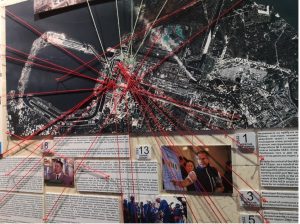 On December 23rd, I went to the Chernobyl Museum to see a new exhibition on the Russian occupation of the Chernobyl Zone and the Zaporizhzhia Nuclear Power Plant. I was in the cab towards Podil when I heard the siren, but the alarm was cancelled before we reached the Museum. Liosha was waiting for me near the Museum’s entrance with the exhibition’s curator, smoking, before his personal tour took us into the Museum’s foyer where the walls were covered with many smaller and larger rectangular text boxes and photos copied from various news outlets and social media. These carefully dated clips were presented chronologically, while red threads tied to red pins linked each piece of news with a particular spot on the satellite images of the nuclear power plants. The visualization method was borrowed from crime movies: the two cases of nuclear terror were presented to the viewer in a form of “evidence boards” also known as “conspiracy boards,” “crazy walls,” or “murder maps.”
On December 23rd, I went to the Chernobyl Museum to see a new exhibition on the Russian occupation of the Chernobyl Zone and the Zaporizhzhia Nuclear Power Plant. I was in the cab towards Podil when I heard the siren, but the alarm was cancelled before we reached the Museum. Liosha was waiting for me near the Museum’s entrance with the exhibition’s curator, smoking, before his personal tour took us into the Museum’s foyer where the walls were covered with many smaller and larger rectangular text boxes and photos copied from various news outlets and social media. These carefully dated clips were presented chronologically, while red threads tied to red pins linked each piece of news with a particular spot on the satellite images of the nuclear power plants. The visualization method was borrowed from crime movies: the two cases of nuclear terror were presented to the viewer in a form of “evidence boards” also known as “conspiracy boards,” “crazy walls,” or “murder maps.”
To produce them, the team followed different channels, consulted with specialists, requested comments from the government and Energoatom, crosschecked the information, and worked in archives before each textbox was added to the wall and linked by the thick threads of red yarn with the satellite view. The presence of the links overpowered the rest of elements, as even its shape itself communicated something about the events that the images and texts alone could not render. The red network brought forward the constellation of different publications selected to guide our understanding of nuclear terror. The method was utterly familiar. This is how I used to write this diary in the beginning, hyperlinking every second phrase with reports and news items. This is how you proceed, probably, before your knowledge of war is formed and settled in you, and you know that by how it weighs you down; from now on, your writing is free to follow only a fleeting sense of self which does not require any links to online sources.
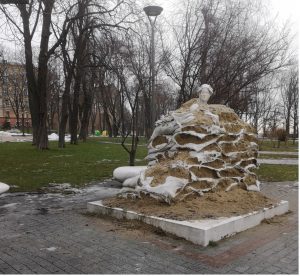 Sirens or not, we would go for a walk every day, Svitlana and I. To hear that one of my favourite routes goes through Saint Volodymyr Hill may sound a bit silly to Kyivans who loathe all touristy spots, and Svitlana, too, gave me that look. The route was a gift to me, however, by my friend Olga, now a professor at Kyiv-Mohyla Academy, whom I met in my early twenties when she ran a film club, where I discovered the joy of arthouse cinema. Twenty years later, when I met with her in my early forties, I discovered the joy of city walks. I can’t tell how or why among all the people with whom I’ve walked many streets of the world, it was she who transformed city strolls into a practice simultaneously meaningful and full of pleasure so that every walk I take ever since – in Kyiv or elsewhere – is dedicated to her. Our meeting spot was near a human-sized marble statue of Dante Alighieri on the top of the hill close to European Square. From there, we went towards Klitschko glass footbridge that opens one of the most breathtaking views of Kyiv’s Podil, especially on the quiet and foggy mornings during the war. The bridge had a narrow escape when a Russian rocket hit the nearby walkway during General Surovikin’s inaugural massive attack of Kyiv on October 10th, but it was immediately tested, fixed, and opened to pedestrians as a variation of the now-famous “fuck-you” gesture to the aggressor.
Sirens or not, we would go for a walk every day, Svitlana and I. To hear that one of my favourite routes goes through Saint Volodymyr Hill may sound a bit silly to Kyivans who loathe all touristy spots, and Svitlana, too, gave me that look. The route was a gift to me, however, by my friend Olga, now a professor at Kyiv-Mohyla Academy, whom I met in my early twenties when she ran a film club, where I discovered the joy of arthouse cinema. Twenty years later, when I met with her in my early forties, I discovered the joy of city walks. I can’t tell how or why among all the people with whom I’ve walked many streets of the world, it was she who transformed city strolls into a practice simultaneously meaningful and full of pleasure so that every walk I take ever since – in Kyiv or elsewhere – is dedicated to her. Our meeting spot was near a human-sized marble statue of Dante Alighieri on the top of the hill close to European Square. From there, we went towards Klitschko glass footbridge that opens one of the most breathtaking views of Kyiv’s Podil, especially on the quiet and foggy mornings during the war. The bridge had a narrow escape when a Russian rocket hit the nearby walkway during General Surovikin’s inaugural massive attack of Kyiv on October 10th, but it was immediately tested, fixed, and opened to pedestrians as a variation of the now-famous “fuck-you” gesture to the aggressor.
Despite all scandalous episodes during the bridge construction in 2019, the connection between the park of Saint Volodymyr Hill and Khreshchatyi Park on the other side of Saint Volodymyr Descent was, admittedly, needed. This idea, advocated back in the 1930s by Ukrainian architect Vasyl Krychevsky, was initially disapproved by the city administration of the Soviet time. For Olga, the continuous walk from one park to another above the street traffic, passing through several of Kyiv’s historical neighborhoods to reveal the incredible landscape of hills and ravines, was essential for experiencing this city. In the morning of December 24th, Svitlana and I walked up towards Saint Volodymyr Hill where, a hundred meters from the glass bridge, Dante met us with an empty stare at the fucked-up world. All his previous glory carried in the marble posture was now lost and he appeared rather like a city lunatic of his era, wrapped in a cocoon of torn and messy sacks of sand serving as a pitiful wartime shield from Russian missiles.
On the morning of December 29th, Kyiv was under a missile attack again. Svitlana had an appointment, and she called her doctor to see if the clinic was open. It was. When we drove fast through an empty avenue at 9am, we heard an explosion somewhere far, far away, but the car, nevertheless, made a jump, and so did our internal organs. There were several patients in line already at the dentist’s office, and people kept coming, while the Telegram channels posted alerts about an approaching Kalibr rocket – “it’s flying very low” – along with drones. “What’s the prognosis?” the receptionist asks a man in a military uniform. “It will be over by midday – there will be one hundred rockets.” “I saw a drone shot this morning, there was a long trail in the sky,” someone said. A click away from the rocket alerts on the same channel, I saw a report about abnormally high-temperature records during this warmest European winter in the longest time, so warm that the cherry trees blossomed three days before the New Year in two places in Kyiv, on Lipsky Boulevard and in Maria Zankovetska Square. The art of living on a damaged planet amidst missile strikes.
When the attack, indeed, was over around noon, we drove towards several small towns in the Kyiv region. As we were slowly passing through Bucha with my face pressed against the car window, bunches of sunrays kept playfully reaching to touch my skin – in and out, in and out, in and out – through multiple bullet holes left by machine guns in the metal fences of Bucha’s houses. My first thought – how beautiful! My second thought, however, is merciless and it brings this vibrant sunray dance back into context with a horrific reality.
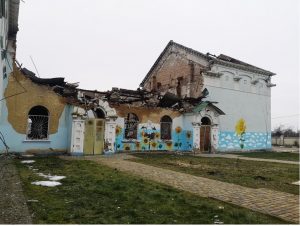
Irpin’s Central House of Culture is now a ruin. Along with museums, libraries, and schools, cultural centers are usual targets for Russian tanks and artillery. The damaged walls of the building that was constructed as a place of community gathering by the collective effort of residents after WWII was recently covered with a painting of a stork nest, the Ukrainian symbol of life, and of sunflowers, which seeds have become a codified death-wish to the enemy – they might bloom when Russian soldiers die. The conservation process has commenced by constructing the roof so that the walls do not deteriorate under the rain and snow before the House is finally restored as a version of itself from before the war.
I stood there, in front of the half-ruined cultural center, and I recalled how a decade ago, my friend Aleksandra invited me to her place in Tribeca, “my husband is great at making mixed drinks,” and so I met, to my complete surprise, one of my intellectual heroes, Lebbeus Woods, a thinker and architect of radical reconstruction. Often accused of “aestheticizing violence,” he argued it is crucial to preserve what is communicated by the architecture damaged in the war. In the end, according to architecture historian and theorist Beatriz Colomina, modern architecture is a medium of mass communication that renegotiates the divisions – inside/outside, private/public – all of which support the organizing principles of modern living. And Woods argued that instead of returning to normalcy by restoring the damaged buildings to their pre-war designs or replacing them with something entirely different to erase the memory of war, there is the third principle where “the post-war city must create the new from the damaged old,” embracing the architectural wounds, accepting the new spaces and forms created by missile strikes, acknowledging the non-accidental place of war in the so-called peace of modernity.
The Chernobyl Zone is a mass medium. The Central House of Culture in Irpin is a mass medium. The Mariupol theater is a mass medium. A modern nuclear power plant, a modern cultural center, and a modern theater have finally told us – by twisting their means inside out – everything we need to know about modernity: modernity is saturated by war.

On December 31st, the air raid alarm caught us at the store near Pecherska metro station in Kyiv. Telegram channels monitoring the trajectories of the attacks communicate the details to different city neighborhoods and suburbs. “Brovary! Several drones are flying towards you! Run to the shelter!” “Boyarka! A rocket is moving in your direction! To the shelter!” “Rusanivka! Drones! To the shelter!” We were close to Svitlana’s home, but according to these Telegram messages, we had to proceed to the metro shelter immediately. The situation looked serious, we texted Asia, visiting from Berlin, to rush to Lybidska station near Svitlana’s place.
We passed through the glass door of the street entrance and stopped at the cash register on the upper level. There were some people already sitting on the floor and standing, but everyone looked eager to leave soon. In less than ten minutes, however, crowds started arriving, so we had to move down. Nearly all the stations of this metro line are deep level underground; built during the precautious times of the Cold War, they are believed to be good enough to hold against a nuclear strike. The oldest of them, the 105.5-metres-deep Arsenalna station from 1960, had been the deepest station in the world, until Hongyancun station opened this year in China. When I took these escalators down to the trains in my student years, always late to my meetings and lectures, I joked that these rides down felt like Jules Verne’s journey to the center of the Earth. We were still on the escalator down, as Telegram channels reported several strikes in the center of Kyiv, but we did not hear a thing in this deep-level cold-war underground.
For the next several hours, I stood there leaning against the yellowish marble wall. Many people were well equipped, they came with folding chairs, yoga mats, and downloaded movies for kids. Everyone was on their phone, checking for updates. People talked about the New Year’s plans, counted the reported explosions in the city – more than ten by that moment. Although the information about the hits is never released immediately, and it is forbidden to post clear photos, everything leaks somehow. Three or four partial snaps and you get the entire picture. The new media literacy of war is enriched by the basics of open-source intelligence. “What if we see the city all ruined when we come out to the surface?” a woman asked me. “Do you often come down here during the attacks?” I asked her in return. “No, first time.” “Me too.”
By four in the afternoon, my phone was dead in my pocket. I was still leaning against that wall, when the air alert was cancelled, and the crowd moved up towards the exit. The enemy releases us from the underground – “go now and chop your salads.” The extreme tiredness mixed with depression that was hunting me for weeks in my hometown finally got me for real, on the last day of the year. I felt I was fading, when we got home, and I told Asia and Svitlana I needed to lie down. When I opened my eyes, it was very quiet. The light in my room was on, and the TV in the living room was off. I suddenly realized it was New Year’s Eve and I got terrified that I slept it all through. Fortunately, it was only a quarter to midnight. Svitlana was furious, however, she said I did not respond when they knocked and assumed I was decidedly ignoring the calls. “Why didn’t you enter the room? I could have been dead…” I wondered and begged her to forgive me as she had to cook the entire dinner for us alone. After I poured us drinks, we hugged at the dinner table just in time for Zelensky’s address to the nation. A pre-recorded New Year concert followed, but I only remember it because it was then, shortly after midnight, that loud explosions resumed. One, two, three – I counted. Telegram channels reported the drone attack on Kyiv, but they reassured us that the air defence was downing them all. The explosions continued and Svitlana was reading the incoming updates for us, as I suddenly stood up, quickly hugged her and without washing my face, went back to bed.
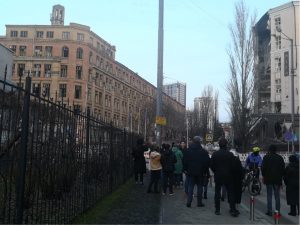
The next morning I finally felt rested. Asia, after her party with friends, and Svitlana, after the drone all-nighter, were still catching up on sleep. I made a coffee and got online to read about yesterday’s strike on Hotel Alfavito, two blocks from Pecherska station where we were hiding. In the afternoon, three of us went there to see the damage. There was a lot of broken and shattered glass on the pavement, making a cracking noise as we were stepping on it. I picked up a piece and put it in my pocket. The windows of the Palace Ukraine, the country’s major concert hall one block away, were also blown. The crossroads near the hotel was blocked by police, and we were turned away without seeing the details of the destruction. I looked around, there was a continuous flow of people doing exactly that – walking up to the blocked crossroad to see the damaged hotel, standing in the distance, secretly taking photos, and walking back. I watched that moving flow for a while – it would have been great to film with a steady camera – a war ritual, a reality check, a job of witnessing, a form of disaster tourism, pure curiosity, an expression of care, none of the above.
On January 3rd, I was on my way home. The curfew time, again, made me arrive at the station way before my scheduled departure. Svitlana dropped me off making sure she is back in time to avoid detention. I walked around the station, all decorated for the holiday season, as I stumbled upon the imitation of an electronic board leaning against the escalator to tracks that listed all temporarily inexistent train routes that stopped operating on the occupied territories. Kyiv – Peremoha. Kyiv – Simferopol. Kyiv – Luhansk. Kyiv – Sevastopol. Kyiv – Lysychank. Kyiv – Mariupol. Kyiv – Yevpatoria. Kyiv – Donetsk. Kyiv – Melitopol. Kyiv – Berdiansk. Kyiv – Kerch. All in green. And only one of them was in white letters – now operating route Kyiv – Kherson. It designated the direction in which de-occupation will proceed. And finally, on the third day of the new year, I sensed the beginning of something. I did not make a wish when the clock struck midnight, and I usually never make New Year wishes, but this time I had to, and I whispered: “Let it be the beginning of the end.”
